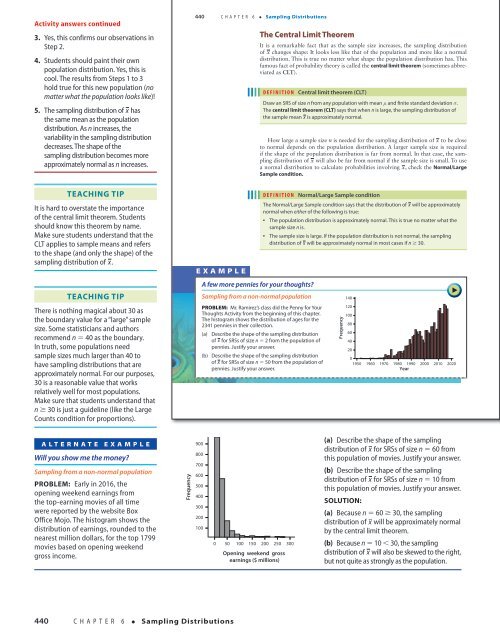SPA 3e_ Teachers Edition _ Ch 6
You also want an ePaper? Increase the reach of your titles
YUMPU automatically turns print PDFs into web optimized ePapers that Google loves.
Activity answers continued<br />
3. Yes, this confirms our observations in<br />
Step 2.<br />
4. Students should paint their own<br />
population distribution. Yes, this is<br />
cool. The results from Steps 1 to 3<br />
hold true for this new population (no<br />
matter what the population looks like)!<br />
5. The sampling distribution of x has<br />
the same mean as the population<br />
distribution. As n increases, the<br />
variability in the sampling distribution<br />
decreases. The shape of the<br />
sampling distribution becomes more<br />
approximately normal as n increases.<br />
440<br />
C H A P T E R 6 • Sampling Distributions<br />
The Central Limit Theorem<br />
It is a remarkable fact that as the sample size increases, the sampling distribution<br />
of x changes shape: It looks less like that of the population and more like a normal<br />
distribution. This is true no matter what shape the population distribution has. This<br />
famous fact of probability theory is called the central limit theorem (sometimes abbreviated<br />
as CLT).<br />
DEFINITION central limit theorem (cLt)<br />
Draw an SRS of size n from any population with mean m and finite standard deviation s.<br />
The central limit theorem (CLT) says that when n is large, the sampling distribution of<br />
the sample mean x is approximately normal.<br />
How large a sample size n is needed for the sampling distribution of x to be close<br />
to normal depends on the population distribution. A larger sample size is required<br />
if the shape of the population distribution is far from normal. In that case, the sampling<br />
distribution of x will also be far from normal if the sample size is small. To use<br />
a normal distribution to calculate probabilities involving x, check the Normal/Large<br />
Sample condition.<br />
Teaching Tip<br />
It is hard to overstate the importance<br />
of the central limit theorem. Students<br />
should know this theorem by name.<br />
Make sure students understand that the<br />
CLT applies to sample means and refers<br />
to the shape (and only the shape) of the<br />
sampling distribution of x.<br />
Teaching Tip<br />
There is nothing magical about 30 as<br />
the boundary value for a “large” sample<br />
size. Some statisticians and authors<br />
recommend n 5 40 as the boundary.<br />
In truth, some populations need<br />
sample sizes much larger than 40 to<br />
have sampling distributions that are<br />
approximately normal. For our purposes,<br />
30 is a reasonable value that works<br />
relatively well for most populations.<br />
Make sure that students understand that<br />
n ≥ 30 is just a guideline (like the Large<br />
Counts condition for proportions).<br />
a<br />
e XAMPLe<br />
A few more pennies for your thoughts?<br />
Sampling from a non-normal population<br />
DEFINITION normal/Large Sample condition<br />
The Normal/Large Sample condition says that the distribution of x will be approximately<br />
normal when either of the following is true:<br />
• The population distribution is approximately normal. This is true no matter what the<br />
sample size n is.<br />
• The sample size is large. If the population distribution is not normal, the sampling<br />
distribution of x will be approximately normal in most cases if n ≥ 30.<br />
PROBLEM: Mr. Ramirez’s class did the Penny for Your<br />
Thoughts Activity from the beginning of this chapter.<br />
The histogram shows the distribution of ages for the<br />
2341 pennies in their collection.<br />
(a) Describe the shape of the sampling distribution<br />
of x for SRSs of size n 5 2 from the population of<br />
pennies. Justify your answer.<br />
(b) Describe the shape of the sampling distribution<br />
of x for SRSs of size n 5 50 from the population of<br />
pennies. Justify your answer.<br />
Frequency<br />
140<br />
120<br />
100<br />
80<br />
60<br />
40<br />
20<br />
0<br />
1950 1960 1970 1980 1990 2000 2010 2020<br />
Year<br />
Alternate Example<br />
Will you show me the money?<br />
Sampling from a non-normal population<br />
PROBLEM: Early in 2016, the<br />
opening weekend earnings from<br />
the top-earning movies of all time<br />
were reported by the website Box<br />
Office Mojo. The histogram shows the<br />
distribution of earnings, rounded to the<br />
nearest million dollars, for the top 1799<br />
movies based on opening weekend<br />
gross income.<br />
Starnes_<strong>3e</strong>_CH06_398-449_Final.indd 440<br />
Frequency<br />
900<br />
800<br />
700<br />
600<br />
500<br />
400<br />
300<br />
200<br />
100<br />
0<br />
50 100 150 200 250 300<br />
Opening weekend gross<br />
earnings ($ millions)<br />
(a) Describe the shape of the sampling<br />
distribution of x for SRSs of size n 5 60 from<br />
this population of movies. Justify your answer.<br />
(b) Describe the shape of the sampling<br />
distribution of x for SRSs of size n 5 10 from<br />
this population of movies. Justify your answer.<br />
SOLUTION:<br />
(a) Because n 5 60 ≥ 30, the sampling<br />
distribution of x will be approximately normal<br />
by the central limit theorem.<br />
(b) Because n 5 10 < 30, the sampling<br />
distribution of x will also be skewed to the right,<br />
but not quite as strongly as the population.<br />
18/08/16 5:03 PMStarnes_<strong>3e</strong>_CH0<br />
440<br />
C H A P T E R 6 • Sampling Distributions<br />
Starnes_<strong>3e</strong>_ATE_CH06_398-449_v3.indd 440<br />
11/01/17 3:58 PM




